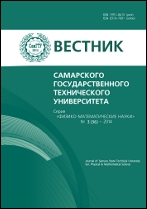|
This article is cited in 22 scientific papers (total in 22 papers)
Mechanics of Solids
The nonlinear Maxwell-type model for viscoelastoplastic materials:
simulation of temperature influence on creep, relaxation and strain-stress curves
A. V. Khokhlov
Lomonosov Moscow State University, Institute of Mechanics, Moscow, 119192, Russian Federation
(published under the terms of the Creative Commons Attribution 4.0 International License)
Abstract:
The nonlinear Maxwell-type constitutive relation with two arbitrary material functions for viscoelastoplastic multi-modulus materials is studied analytically in uniaxial isothermic case to reveal the model abilities and applicability scope and to develop techniques of its identification, tuning and fitting. The constitutive equation is aimed at adequate modeling of the rheological phenomena set which is typical for reonomic materials exhibiting non-linear hereditary properties, strong strain rate sensitivity, secondary creep, yielding at constant stress, tension compression asymmetry and such temperature effects as increase of material compliance, strain rate sensitivity and rates of dissipation, relaxation, creep and plastic strain accumulation with temperature growth. The model is applicable for simulation of mechanical behaviour of various polymers, their solutions and melts, solid propellants, sand-asphalt concretes, composite materials, titanium and aluminum alloys, ceramics at high temperature and so on.
To describe the influence of temperature on material mechanical behavior (under isothermic conditions), two scalar material parameters of the model (viscosity coefficient and “modulus of elasticity”) are considered as a functions of temperature level. The general restrictions on their properties which are necessary and sufficient for adequate qualitative description of the basic thermomechanical phenomena related to typical temperature influence on creep and relaxation curves, creep recovery curves, creep curves under step-wise loading and quasi-static stress-strain curves of viscoelastoplastic materials are obtained. The restrictions are derived using systematic analytical study of general qualitative features of the theoretic creep and relaxation curves, creep curves under step-wise loading, long-term strength curves and stress-strain curves at constant strain or stress rates generated by the constitutive equation (under minimal restrictions on material functions) and their comparison to typical test curves of stable viscoelastoplastic materials. It is proved that the viscosity coefficient and the “modulus of elasticity” of the model and their ratio (i.e. relaxation time of the associated linear Maxwell model) should be decreasing functions of temperature. This requirements are proved to provide an adequate qualitative simulation of a dozen basic phenomena expressing an increase of material compliance (a decrease of tangent modulus and yield stress, in particular), strengthening of strain rate sensitivity and acceleration of dissipation, relaxation, creep and plastic strain accumulation with temperature growth.
Keywords:
nonlinear viscoelastoplasticity, isothermic conditions, influence of temperature, relaxation curves, creep curves, step-wise loadings, stress-strain curves, yield stress, rate sensitivity, superplasticity, ratcheting, polymers.
Received: December 6, 2016
Revised: March 6, 2017
Accepted: March 13, 2017
First online: April 3, 2017
Citation:
A. V. Khokhlov, “The nonlinear Maxwell-type model for viscoelastoplastic materials:
simulation of temperature influence on creep, relaxation and strain-stress curves”, Vestn. Samar. Gos. Tekhn. Univ., Ser. Fiz.-Mat. Nauki [J. Samara State Tech. Univ., Ser. Phys. Math. Sci.], 21:1 (2017), 160–179
Linking options:
https://www.mathnet.ru/eng/vsgtu1524 https://www.mathnet.ru/eng/vsgtu/v221/i1/p160
|

|




 Contact us:
Contact us: Terms of Use
Terms of Use
 Registration to the website
Registration to the website Logotypes
Logotypes









 Citation in format
Citation in format 
